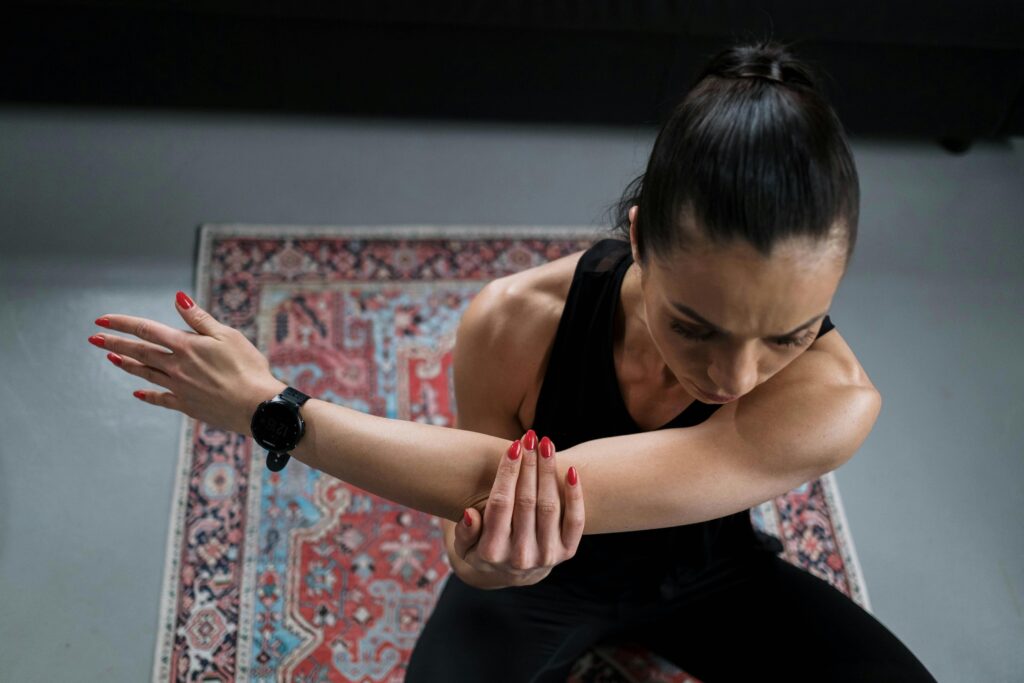Table of Contents
Yoga and Pregnancy marks a time of incredible transformation in a woman’s life, bringing about many changes in the body and mind. While every part of the journey is special, maintaining a balanced routine of physical activity during pregnancy is vital for overall health.
Yoga, a practice known for its flexibility and stress-relieving benefits, is often recommended to pregnant women. But what about heated yoga?
With the rise of heated yoga classes, expecting mothers frequently ask themselves whether practicing yoga in a warm environment is safe or beneficial during pregnancy. Is the heat an added benefit, or does it pose risks to both the mother and the baby?
In this guide, we will explore the ins and outs of practicing heated yoga during pregnancy. We’ll cover what heated yoga actually entails, how the warmth might affect your practice, the potential risks, and the benefits.
With expert insights and careful guidance, expecting mothers can make informed decisions about whether heated yoga is right for them during this delicate time.
What Exactly Is Heated Yoga and Pregnancy ?
Heated yoga refers to yoga practices carried out in a room that’s deliberately warmed to a higher temperature, typically between 80°F and 105°F (27°C to 40°C). The goal of this heat is to help muscles relax, enhance flexibility, promote sweating, and encourage detoxification.
These warm environments can also help create a deeper connection between the body and mind.
There are various styles of heated yoga, with two of the most popular being Bikram Yoga and Hot Vinyasa Yoga.
- Bikram Yoga: This style is practiced in a room heated to 105°F. It follows a fixed sequence of 26 postures and two breathing exercises. Bikram Yoga focuses on building strength, flexibility, and stamina through a structured, intense practice.
- Hot Vinyasa Yoga: In Hot Vinyasa, yoga poses flow together in a sequence, synchronized with breath. The room temperature is typically set between 90°F and 100°F, and each class can vary based on the instructor’s approach, offering flexibility and creativity within the practice.
While both styles of heated yoga provide numerous benefits like improved flexibility and muscle relaxation, pregnancy presents additional factors that may impact the practice, especially when it comes to the heat.

Why Staying Active During Pregnancy Matters
Exercise plays an integral role in a healthy pregnancy. It offers a wide range of benefits to both the mother and the growing baby. Engaging in physical activity can alleviate common pregnancy discomforts like back pain, fatigue, and swelling.
Additionally, regular movement helps reduce the risk of pregnancy complications such as gestational diabetes, high blood pressure, and excessive weight gain. Physical activity also boosts mood, improves sleep, and enhances overall energy levels.
However, not all forms of exercise are suitable for pregnancy. Some activities—especially those that involve intense heat, high-impact movements, or excessive physical strain—might not be the best choices. This is where heated yoga presents unique challenges and considerations for expecting mothers.
Risks of Heated Yoga During Pregnancy: What You Need to Know
Although heated yoga can provide benefits, there are several important risks to consider before deciding if it’s right for you during pregnancy. The main concern is overheating, which can be detrimental to both the mother and her unborn baby.
Your body undergoes various physiological changes while pregnant, and adding additional stress with heat can exacerbate these changes.
Here are some critical risks linked with heated yoga during pregnancy:
Overheating and Hyperthermia
Hyperthermia refers to the condition of the body overheating. During the early stages of pregnancy, when the baby’s organs and nervous system are still developing, overheating is especially concerning. Excessive heat can increase the risk of birth defects, including neural tube defects.
The first trimester is particularly sensitive, so pregnant women should be cautious about exposing themselves to high temperatures during this period.
Dehydration
One of the hallmark features of heated yoga is intense sweating, which can lead to dehydration. Pregnant women are naturally more susceptible to dehydration, and adding heat into the mix can make this problem worse.
Dehydration can lead to several complications, including low amniotic fluid, increased risk of preterm labor, and contractions. Maintaining proper hydration is crucial during pregnancy, especially when practicing yoga in a heated environment.
Blood Pressure Drops
Heated yoga can cause a temporary drop in blood pressure. For pregnant women who are already dealing with low blood pressure due to hormonal changes, this drop can be particularly dangerous.
It may lead to dizziness, lightheadedness, fainting, or even falls—creating the potential for injury to both the mother and the baby.
Risk of Overexertion
The added heat during a heated yoga class can increase the physical intensity of the practice. This might lead to overexertion, which is not ideal during pregnancy. Overexertion can leave you feeling exhausted, dizzy, or fatigued—symptoms that are already common in pregnancy.
It is essential to listen to your body and avoid pushing past your limits.
The Benefits of Heated Yoga During Pregnancy: A Closer Look
While there are risks associated with heated yoga, practicing it safely and mindfully can provide several benefits to expecting mothers. Let’s explore how heated yoga, when done correctly, can enhance your pregnancy experience:
Improved Flexibility
The warmth in a heated yoga room helps relax muscles, which allows for a deeper range of motion and greater flexibility. During pregnancy, hormones like relaxin cause the ligaments and joints to loosen, making it easier to stretch and increase flexibility.
This can help reduce the discomfort caused by tight hips, lower back pain, and sore muscles—common ailments during pregnancy.


Muscle Tension Relief
Heated yoga promotes better circulation, which can ease muscle stiffness and alleviate common pregnancy-related aches, especially in the lower back and hips. The warmth increases blood flow, which may help reduce swelling in the legs and feet, another common symptom of pregnancy.
Reduced Stress and Better Emotional Health
Yoga itself is known for promoting emotional well-being and reducing stress. The heat in a heated yoga class can enhance the relaxation response, calming both the mind and the body. Pregnancy can be an emotional rollercoaster, with anxiety, mood swings, and heightened stress levels.
Heated yoga can help bring a sense of peace, emotional balance, and stress relief during this transformative time.


Better Circulation
The warmth from the room encourages improved blood flow, which is beneficial for both the mother and the baby. Enhanced circulation can help with common pregnancy issues like swelling in the legs and feet. Additionally, better circulation ensures that oxygen and nutrients are efficiently delivered to both the mother and the developing baby.
Breathing Techniques for Labor
Yoga is well-known for its focus on breathing exercises, and these techniques can be incredibly valuable during labor and delivery. Practicing controlled breathing in a heated yoga class can help expecting mothers manage pain, stay calm, and prepare mentally for childbirth.
How to Practice Heated Yoga Safely During Pregnancy
If you’re expecting and thinking about trying heated yoga, it’s important to approach it cautiously. Here are some tips to ensure a safe and beneficial experience:
Consult Your Healthcare Provider
Before starting heated yoga, speak with your healthcare provider to ensure it’s safe for you based on your pregnancy history, health condition, and specific needs.
Listen to Your Body
Pregnancy changes your body’s needs and abilities, so modify your practice accordingly. Avoid poses that require deep twists, inversions, or heavy abdominal strain. Focus on gentle stretches and relaxation, paying attention to how your body responds throughout the practice.
Stay Hydrated
Hydration is key to a safe yoga practice, especially when heat is involved. Drink plenty of water before, during, and after class to stay properly hydrated. This is crucial during pregnancy, as dehydration can be more dangerous for both the mother and the baby.
Pay Attention to Room Temperature
It’s essential to monitor your body temperature during the class. If you feel too hot, lightheaded, or dizzy, take a break or exit the room. It’s better to be safe than sorry—don’t hesitate to step out of the heated environment if you feel uncomfortable.
Choose the Right Class
Opt for a class that is designed specifically for pregnant women or a class that allows for modifications and gentle movements. Avoid intense classes where the heat might be too extreme.
Alternatives to Heated Yoga During Pregnancy
If heated yoga doesn’t feel right for you during pregnancy, there are plenty of alternatives that offer similar benefits:
- Gentle Prenatal Yoga: These classes focus on pregnancy-safe movements, stretches, and breathing techniques. They are less intense and more focused on relaxation.
- Non-Heated Vinyasa: For those who enjoy a flowing practice, a non-heated Vinyasa class is a great option. You’ll still get the benefits of breathwork, flexibility, and strength, but without the added heat.
- Prenatal Pilates: Pilates strengthens the core and improves posture while being gentle on the body. Prenatal Pilates classes are specifically designed to cater to the needs of expecting mothers.
- Meditation & Mindfulness: These practices focus on emotional balance and mental clarity, helping to reduce stress and improve emotional health during pregnancy.


Conclusion: Should You Practice Heated Yoga During Pregnancy?
Heated yoga can offer numerous benefits for pregnant women when practiced carefully and safely. However, it is not without risks—especially the potential for overheating and dehydration. It is crucial to listen to your body, modify your practice, and stay hydrated while being mindful of the temperature and intensity of the class. Always consult with your healthcare provider before trying any form of heated yoga during pregnancy.
If you’re unsure about whether heated yoga is right for you, consider exploring other alternatives, such as non-heated yoga, Pilates, or mindfulness practices. The goal is to find a form of exercise that makes you feel comfortable and supports your physical and emotional well-being throughout your pregnancy.
